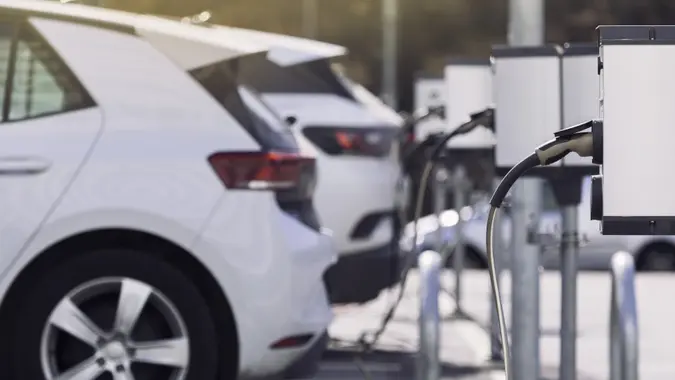Advertiser Disclosure
GOBankingRates works with many financial advertisers to showcase their products and services to our audiences. These brands compensate us to advertise their products in ads across our site. This compensation may impact how and where products appear on this site. We are not a comparison-tool and these offers do not represent all available deposit, investment, loan or credit products.
Unplug These 8 Appliances That Will Hike Up Your Electricity Bill This Winter
 Written by
Crystal Mayer
Written by
Crystal Mayer
 Edited by
Ashleigh Ray
Edited by
Ashleigh Ray

Commitment to Our Readers
GOBankingRates' editorial team is committed to bringing you unbiased reviews and information. We use data-driven methodologies to evaluate financial products and services - our reviews and ratings are not influenced by advertisers. You can read more about our editorial guidelines and our products and services review methodology.

20 YearsHelping You Live Richer

Reviewed by Experts

Trusted by Millions of Readers
The average U.S. household pays around $142 for electricity each month, according to SaveOnEnergy’s November 2024 report.
That amount, however, varies greatly depending on where you live. For instance, Hawaiians have the highest average electricity bill at $212 per month, while people in Utah generally pay around $89 per month.
Whether you wake up to the endless vistas of Bryce Canyon or the tropical paradise of Kauai, you may be wondering how you can save a little money this winter. GOBankingRates asked energy and financial experts to weigh in on which appliances hike up the cost of your electricity bill in the winter.
Here are the eight electricity-guzzling devices you might want to consider unplugging.
Hot Water Recirculation Pump
As a serial climate tech entrepreneur, Andrew Meyer, CEO of Arbor, has a mission to help everyone save money and live more sustainably.
“If you want to save money on your electricity bill this winter, unplug your hot water recirculation pump,” he said. “Plug it into a timer instead and program it to switch off in the middle of the night when no one is using hot water. This can save you between $30 [and] $95 annually.”
Space Heaters
Vikas Kaushik, CEO of TechAhead, recommended unplugging your space heater.
“These devices have the potential to consume a lot of energy,” he said. “If you must use a space heater, use it in the rooms where you spend most of your time and only when necessary.”
Electric Water Heaters
“To minimize heat loss,” Kaushik said, “think about insulating your water heater and lowering the temperature. Additionally, think about conserving hot water by doing laundry with cold water and taking shorter showers.”
Inefficient Lights
Kaushik also mentioned turning off or replacing inefficient lighting.
“Older fluorescent lights and incandescent bulbs waste energy,” he warned. “Make the switch to energy-saving LED or CFL bulbs, which generate less heat and need less electricity.”
Unused Electronics
With the growing number of electronic devices in each household, the more you can unplug, the better.
“Even when they are turned off, a lot of electronic devices still draw power while they are connected,” Kaushik explained. “When not in use, unplug game consoles, chargers and other electronics. Alternatively, utilize smart power strips to simultaneously turn off the power to several devices.”
Televisions
“While more energy-efficient now, older models can still use a lot of power,” Kaushik said.
If you have an older model, Kaushik suggests replacing it with a more energy-efficient one.
He also recommended, “When you’re not actively viewing TV, turn it off as well. You may lower your wintertime power costs and improve the energy efficiency of your house by paying attention to these appliances and taking action to limit their energy usage.”
Secondary Refrigerators
Brian Meiggs, an entrepreneur and the founder of My Millennial Guide, said, “Older fridge and freezer units in the garage or basement can use quite a bit of energy even when running sparingly.
Meiggs explained that unplugging the extra fridge and consolidating items into your primary refrigerator “can shave up to $100 off your winter electricity costs.”
Electric Stoves and Ovens
“Cooking with electric stoves and ovens, especially for extended periods, can significantly contribute to your electricity bill,” Meiggs said.
“Cook multiple items simultaneously to maximize oven use. Use lids on pots and pans to cook food faster. Consider investing in energy-efficient induction cooktops, which heat up faster and waste less energy. Opt for smaller kitchen appliances like microwaves or toaster ovens for reheating and smaller meals, as they use less energy than conventional ovens.”
Start Saving on Your Electricity Now
In addition to unplugging these energy-wasting appliances this winter, you also can invest in smart technology that might help you save even more over the long term. Think about smart plugs and smart thermostats that allow you to program when to turn the device on or off.
You also might want to check with your electricity company to see whether it has any money-saving programs. For example, you might save more if you avoid running your main appliances, like your dishwasher and dryer, between certain hours. While it might not seem like a lot, the savings can add up substantially over time. If you are really ready to make an energy-saving investment, you can always look into installing solar.
Share This Article:




You May Also Like


Most Americans Blame AI for Higher Utility Bills, but Is It Really at Fault?
November 10, 2025
5 min Read

Thinking of Buying a Cheap Car? Hidden Costs You Need To Be Prepared for
November 10, 2025
5 min Read







4 Times It's Actually Smarter To Buy New Over Used, According to Car Experts
November 13, 2025
5 min Read




I'm a Travel Expert: 6 Top Destinations for Retirees on a Budget in Late 2025
November 13, 2025
5 min Read

Best Ways To Save Your Money
Make your money work for you
Get the latest news on investing, money, and more with our free newsletter.
By subscribing, you agree to our Terms of Use and Privacy Policy. Unsubscribe at any time.


Thanks!
You're now subscribed to our newsletter.
Check your inbox for more details.



Sending you timely financial stories that you can bank on.
Sign up for our daily newsletter for the latest financial news and trending topics.
For our full Privacy Policy, click here.
Looks like you're using an adblocker
Please disable your adblocker to enjoy the optimal web experience and access the quality content you appreciate from GOBankingRates.
- AdBlock / uBlock / Brave
- Click the ad blocker extension icon to the right of the address bar
- Disable on this site
- Refresh the page
- Firefox / Edge / DuckDuckGo
- Click on the icon to the left of the address bar
- Disable Tracking Protection
- Refresh the page
- Ghostery
- Click the blue ghost icon to the right of the address bar
- Disable Ad-Blocking, Anti-Tracking, and Never-Consent
- Refresh the page



